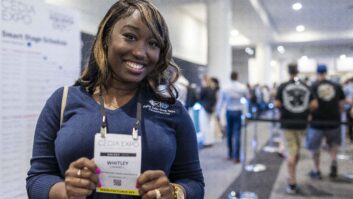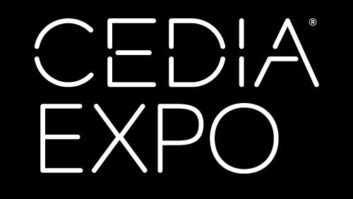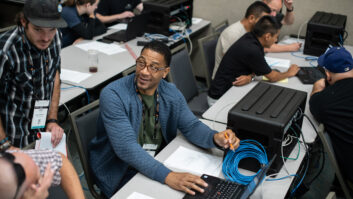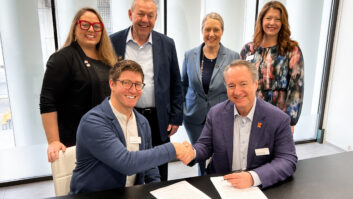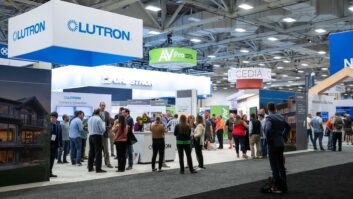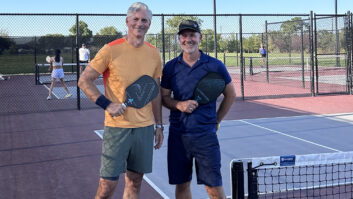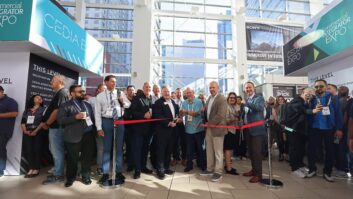The federal government could learn a lesson from CEDIA EXPO manufacturers that have reached across party lines more than ever before in an effort to cross-pollinate the home automation industry.
NEST
An inviting slide from CEDIA keynoter, Tony Fadell, founder and CEO of Nest
From the keynote with Tony Fadell, founder and CEO of the Nest, throwing up a slide stating, “Let’s start working together,” to the show floor where all manufacturers touted two-way modules for other devices, it was undisputable that our industry has taken a step in the right direction.
Not only did Nest say it wanted to work together, the once closed off company also announced a partnership with Control4 that led to that automation brand’s demonstration of its integration with Nest in its CEDIA EXPO booth. And, Nest had a booth at the show for the first time. Nest has agreed to work with others, a well, proving that this sexy thermostat will now be part of a larger ecosystem all while saving you money.
There was more open-ness at EXPO. Total Control by URC announced a partnership with Extra Vegetables, allowing integration with Sonos. (Should you not know who Extra Vegetables, it’s a company that extends “the possibilities of a control system through add-on drivers, utilities, and apps.” They exist to get everyone to work together.)
Up until now Sonos was a bit of an integration killer. If the client preferred the concept (or marketing) of a Sonos system, it was difficult to integrate within a larger system. Not any more! Bitwise also announced a two-way module allowing for Sonos to be part of the system instead of the system itself.
Z-Wave, the “only wireless technology that truly allows you to control your home devices from anywhere in the world” was all over the show floor, as well. They are now a working technology inside Kwickset, Leviton, Yale, URC, and Honeywell, just to name a few.
Sony showed off high-resolution players that are controlled via iOS devices and Android devices. It’s a big step for Sony to play well with others. Until now, the manufacturer tended to be so proprietary that it had killed products and/or the technologies in the past rather than adapt them to changing tastes.
I admit I am a huge fan of great music, but I also believe there is a “good enough” factor, so hi-res audio has not excited me. However, Sony seems to have done a good job with this product. They will allow you to import all your existing music (even if it currently resides in iTunes). Units can work as stand-alone devices or as a source in a larger system. Three players were announced at the show. Sony believes that as they improved your picture with HD they can now focus on improving our audio quality with Hi-Res.
Hi-Res is “typically referred to as “96kHz/24bit” or something higher… but there is no single standard.” Because no one has agreed on a common technology, there are currently about six different formats of lossless audio. And with “the decreasing cost of storage media, plus faster internet speeds and our ability to have music in its purest form wherever we go,” Sony believes that consumer demand exists. I guess only time will tell.
SONY
Sony showed off Hi-Resolution players that are controlled via iOS devices and Android devices. It’s a big step for Sony to play well with others.
Not to be left out of all of this open-ness, Crestron released its new application marketplace allowing those with the best programming skills to sell (although some are free) their “apps” (modules, IR drivers) to the world. This could make Crestron more accessible to those who may be overwhelmed by the design and programming aspect. No one can deny that Crestron is a solid company, especially since they have been on the automation forefront for 40 years. The biggest complaint I’ve heard on social media about the marketplace is that it could make it too easy for other integrators to sell Crestron.
CRESTRON
Crestron released its new application marketplace allowing those with ‘mad’ programming skills to sell (although some are free) these ‘apps’ (modules, IR Drivers) to the world.
Each Crestron app can be rated and the better the rated apps will show up in the application market. It is a pretty neat concept in uniting programmers and making the product, as a whole, better. This is a step forward for the entire automation industry.
So while federal government continues to get paid and not work or communicate, CEDIA EXPO proved that party lines can be crossed. Were you at the show? Who else was playing well in the same sandbox?

